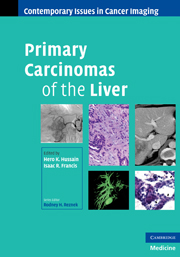Book contents
- Frontmatter
- Contents
- Contributors
- Series foreword
- Preface to Primary Carcinomas of the Liver
- 1 Epidemiology of hepatocellular carcinoma and cholangiocarcinoma
- 2 Surveillance and screening for hepatocellular carcinoma
- 3 Pathology of hepatocellular carcinoma, cholangiocarcinoma, and combined hepatocellular-cholangiocarcinoma
- 4 Radiological diagnosis of hepatocellular carcinoma
- 5 Staging of hepatocellular carcinoma
- 6 Surgical treatment of hepatocellular carcinoma: resection and transplantation
- 7 Non-surgical treatment of hepatocellular carcinoma
- 7.1 Regional therapies for treatment of intermediate-stage hepatocellular carcinoma
- 7.2 Systemic therapies for advanced hepatocellular carcinoma
- 8 Radiological identification of residual and recurrent hepatocellular carcinoma
- 9 Radiological diagnosis of cholangiocarcinoma
- 10 Staging of cholangiocarcinoma
- 11 Treatment of cholangiocarcinoma
- 12 Uncommon hepatic tumors
- Index
- Color plates
- References
7.1 - Regional therapies for treatment of intermediate-stage hepatocellular carcinoma
from 7 - Non-surgical treatment of hepatocellular carcinoma
Published online by Cambridge University Press: 04 August 2010
- Frontmatter
- Contents
- Contributors
- Series foreword
- Preface to Primary Carcinomas of the Liver
- 1 Epidemiology of hepatocellular carcinoma and cholangiocarcinoma
- 2 Surveillance and screening for hepatocellular carcinoma
- 3 Pathology of hepatocellular carcinoma, cholangiocarcinoma, and combined hepatocellular-cholangiocarcinoma
- 4 Radiological diagnosis of hepatocellular carcinoma
- 5 Staging of hepatocellular carcinoma
- 6 Surgical treatment of hepatocellular carcinoma: resection and transplantation
- 7 Non-surgical treatment of hepatocellular carcinoma
- 7.1 Regional therapies for treatment of intermediate-stage hepatocellular carcinoma
- 7.2 Systemic therapies for advanced hepatocellular carcinoma
- 8 Radiological identification of residual and recurrent hepatocellular carcinoma
- 9 Radiological diagnosis of cholangiocarcinoma
- 10 Staging of cholangiocarcinoma
- 11 Treatment of cholangiocarcinoma
- 12 Uncommon hepatic tumors
- Index
- Color plates
- References
Summary
Hepatocellular carcinoma (HCC) incidence is increasing worldwide. Without treatment, the prognosis is poor and the 5-year survival rate is less than 5%. Surgical resection, liver transplantation, and percutaneous ablation are the only effective treatments that offer improved survival and long-term cure. However, only 15–30% of patients with HCC are surgical candidates at initial presentation because of tumor extension, multiplicity of tumor foci, and associated advanced liver cirrhosis. When the tumor is unresectable, a variety of other locoregional treatments are offered to improve the quality and duration of life, such as transarterial chemoembolization (TACE), systemic chemotherapy, and radiation therapy. Among these, TACE has been in use since the mid-1970s and has a proven survival benefit.
This chapter discusses the rationale, the technique and protocols, the patient selection criteria, and the risks and benefits of TACE. Current trends toward multimodality treatment are also discussed.
Vascular anatomy of the liver
The liver receives dual blood supply; approximately one-third from the hepatic artery and the remaining two-thirds from the portal vein. The arterial supply to the liver usually comes from the celiac artery via the common hepatic artery that branches into the gastroduodenal and proper hepatic arteries (Figure 7.1a.1). The proper hepatic artery then branches into right and left hepatic arteries, which in turn follow the segmental pattern defined by Couinaud's segmental anatomy.
- Type
- Chapter
- Information
- Primary Carcinomas of the Liver , pp. 66 - 96Publisher: Cambridge University PressPrint publication year: 2009



